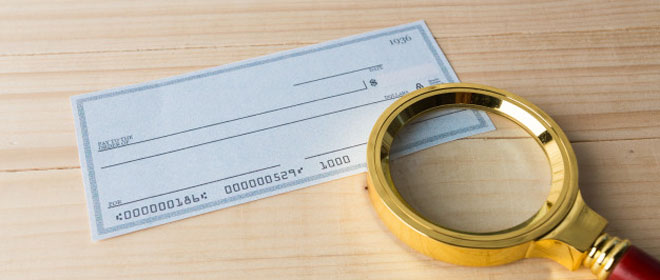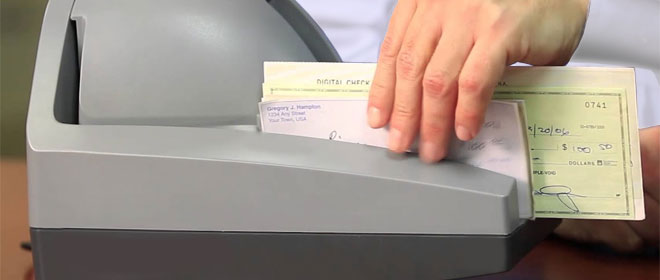
Over 24-billion dollars were lost due to payment fraud across the globe in 2018 alone. The demand for security while conducting financial transactions is at an all-time high. With the ability to purchase goods available at the touch of a button, the security associated with mobile purchases has increased at a breakneck speed.
It’s commonplace for phones to scan your fingerprint or even do a facial recognition scan to authorize payment. It seems like it’s ripped straight out of a 1970’s sci-fi film, but these methods of authorization act as a much-needed extra gate of security.
In such a fast-paced world riddled with digital precautions and overt safety options for almost everything, you would think that our physical banking security would be adapting just as fast.
However, we still use a security process implemented in 1958, called MICR, which is used for all checks issued in the U.S.
No, this is not a backhanded compliment but rather a testament to the quality and effectiveness of the process itself. This highly effective security precaution has been used for over 60-years and doesn’t seem to be going away anytime soon.
What Does MICR Stand For?
MICR stands for Magnetic Ink Character Recognition and is a technology used to enhance the security of personal and business documents.
Checks that are printed with magnetic ink are easily identified by scanners equipped with MICR read heads. This allows checks to be processed securely, instantaneously, and with a high degree of accuracy.
Magnetic ink character recognition has become synonymous with financial transfers, so much so that the MICR line on checks has become the industry standard established by the American Banking Association (ABA).
The Brief History of MICR Ink
During the early years of the 1950s, checks were processed manually by bank tellers using either a Top Tab Key or Sort-A-Matic process of ‘automation’. Unfortunately, the high risk of human error existed in both methods. Thousands of dollars could be lost due to a wrongfully punched hole or a check being placed in the wrong sorting slot. Even by 1950s standards, these methods were slow and had the potential to be detrimental to a financial institution if used incorrectly.
By the mid-50s, the number of checks being widely used and processed increased significantly.
The problem was clear as day and required a solution that reduced the liability of human interaction.
Around that time, the Stanford Research Institute was hard at work crafting their Electronic Recording Method of Accounting, also known as ERMA. Commissioned by Bank of America, the project sought to find a solution to the large influx of checks being processed by hand. By September of 1955, the same team created magnetic ink character recognition as part of its ERMA initiative project and had promising results.
After years of testing and refinement, MICR had become a safe and revolutionary method that solved most problems associated with manual check processing. Magnetic ink character recognition has become so widely accepted and successful that by 1958, the American Banking Association deemed it as the standard that should be used by all financial institutions going forward.

How Does Magnetic Ink Work?
MICR ink bridges the gap between humans and computer communication. Magnetic ink can be read by computers instantaneously through its hidden magnetic language, similar to barcodes. In addition, MICR fonts also resemble physical numeric characters which humans can easily read.
Underneath the surface of every character printed with MICR ink lies a hidden magnetic code that is indecipherable to the human eye. Magnetic ink contains iron oxide particles that are magnetically charged when printed.
When processed by a MICR reader, the machine deciphers the numbers based on its magnetic property rather than what numeric character it resembles on the outside.
Instead of interpreting the entire character as a whole, a MICR reader reads four separate magnetic charges to decode which corresponding number is being inputted. Each character holds two positive and two negative magnetic charges along the linear track.
Think of magnetic charges as security gates. With four “gates” per character and over 40 characters per check, a check must flawlessly pass over 160 checkpoints before it can be processed.
If there is even a single discrepancy with the magnetic code, it will raise an alarm for the bank teller to manually inspect the check.
See how much you can save on your HP ink cartridges.
What are MICR Fonts?
Magnetic ink is used in tandem with a unique font that is positively/negatively charged to add a layer of protected encryption. There are two types of MICR fonts that are globally accepted, E13-B and CMC-7.
The E13-B font is the standard MICR font used in North America and other various parts of the world.
E13-B is used on the ‘MICR line’, which is found on the bottom of the check and includes important information such as the Account, Routing, and Check numbers.
E13-B contains ten numeric characters and four specialized symbols, which denote Transit, Amount, On-Us, and Dash.

While the U.S. fully embraces the E13-B font, other countries around the globe opt for the CMC-7, which more closely resembles a barcode.

CMC-7 is mainly used by South America as well as the majority of Europe and other countries scattered around the globe. The barcode functionality allows room for less error when being read by MICR scanners.
E13-B is often criticized for the ‘5’ and ‘2’ characters being too similar in both shape and magnetic properties. The magnetic wavelengths of a misprinted ‘5’ can easily be mistaken for a correct ‘2’, leading to false red flags raised when processing checks.
Although CMC-7 is technically more accurate, it is often criticized for being much harder to read by the human eye due to its scattered nature within each character.
Although both fonts may have minor differences, they are both processed by MICR reading technology the same way.
When processing a check, it must pass through the machine at a very precise speed. If processed too fast or too slow, it will not be able to be read properly. Very seldom does the MICR reading technology end on a faulty note, as they are proven to have over 96% accuracy when reading checks.
Why MICR Ink is Important Today?
It is normal to be skeptical over a security process that was implemented in the late 50s. Although the magnetic ink character recognition was developed decades ago, it had over 60-years to improve and continuously push its own protection limits to form the high-security version of MICR we have today.
Magnetic ink has become increasingly more available to the public over the years. Especially in the modern era, it’s completely feasible to own a MICR printer for your business to ensure the safety and legitimacy of your documents.
MICR Printer manufacturer, TROY, has partnered with HP to provide the public with reasonably priced specialty MICR printers and MICR toner cartridges.
By owning a MICR printer, you can operate without any check stock laying around. You can keep your operation safe by only printing the checks that are meant to be produced instead of having pre-printed checks that can be unlawfully filled out.
MICR printing isn’t exclusively used for producing checks. Although magnetic ink is used mainly with financial services, it is continuing to transform both the medical industry and government fields.
MICR ink has most recently been used to provide authenticity regarding documents such as medical prescriptions and vital records such as birth, marriage, and death certificates. The high adhesion of text onto papers also deters any potential counterfeiters since MICR ink is not easily scraped or washed out without ruining the entire document itself. This extra code of encryption can prevent any fraudulent attempts or mishaps in their respective realms.
By being extremely hard to replicate, MICR printing technology has pushed the realm of security. It continues to be the number one safety precaution used in the modern era of printing.
Are You Looking for MICR Printer Ink?
If you are looking for MICR toner, 1ink can help! These cartridges are for specific applications such as check printing. Therefore, we may have to special order your toner cartridge. Please contact our support team to help you choose the right MICR toner for your printer.
